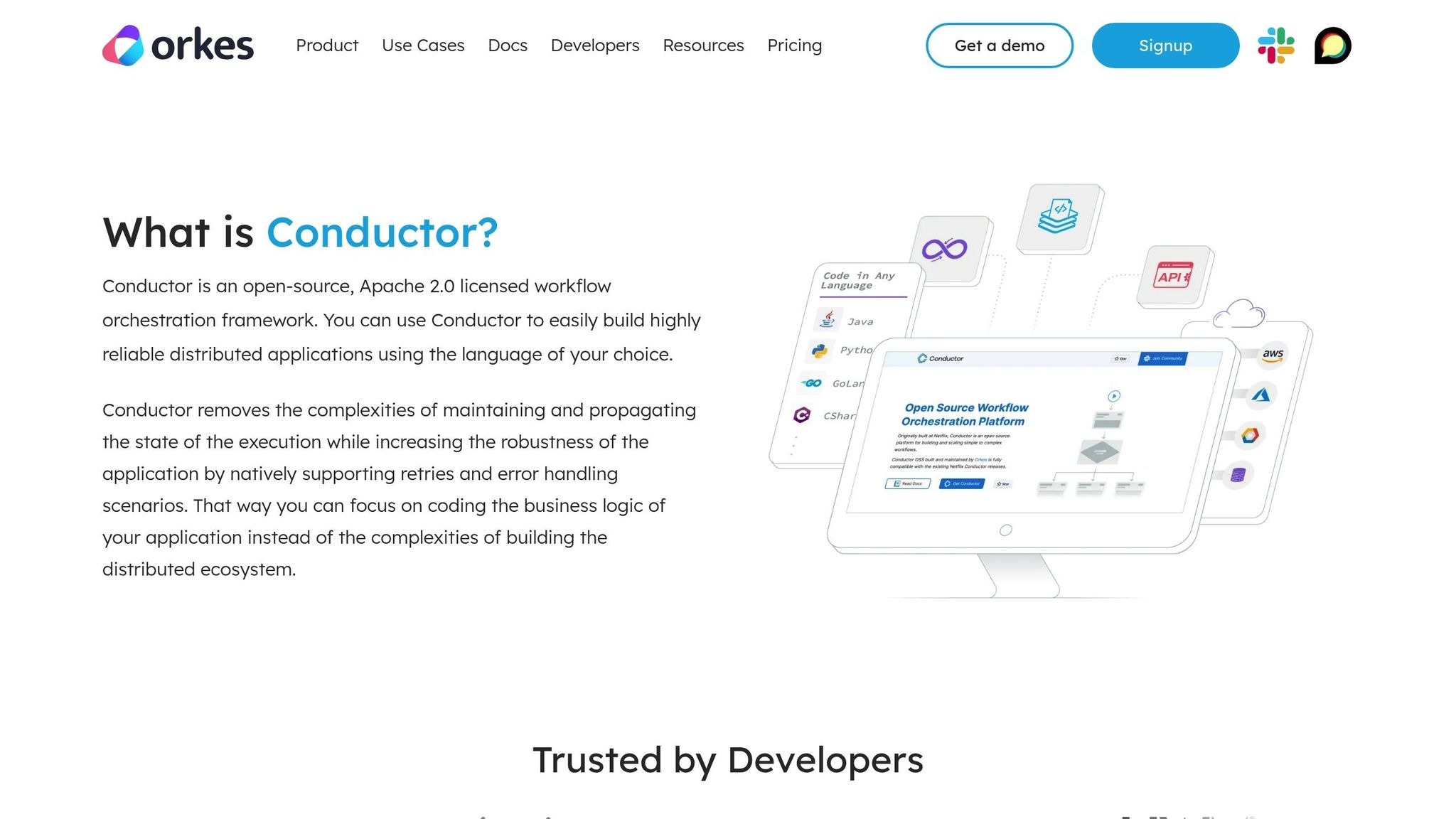Real-time alerts help businesses tackle problems as they arise, improving workflow efficiency and reducing delays. They notify teams instantly about missed opportunities, errors, or bottlenecks, enabling quick action. Here's why they matter:
- Save Time: Automate repetitive tasks, freeing up resources.
- Spot Issues Early: Identify and fix problems before they grow.
- Make Smarter Decisions: Use real-time data to adjust and optimise processes.
- Boost Efficiency: Eliminate delays and improve lead follow-ups.
Key Features of an Alert System:
- Customisable triggers and thresholds.
- Multiple notification methods (email, SMS, push notifications).
- Integration with tools like CRMs and project management software.
- Clear priority levels (Critical, High, Medium, Low).
Example Metrics to Track:
- Lead response times.
- Task delays.
- Sales conversion rates.
- System error rates.
Alerting with Conductor Workflows

Main Advantages of Real-Time Alerts
Real-time alerts change the way businesses track and manage their workflows, helping improve efficiency and avoid missed opportunities.
Spot Problems Instantly
With instant alerts, teams can address workflow issues as they happen, stopping them from turning into bigger problems. This quick action allows for smarter, data-based decisions.
Smarter Business Choices
Real-time alerts deliver up-to-the-minute data, helping businesses make faster, more informed decisions. They can highlight busy periods, uncover customer trends, and point out process inefficiencies, making it easier to adjust resources on the fly.
Save Time and Resources
These alerts streamline how resources are used and reduce wasted time. By automating repetitive tasks like supplier checks or following up on leads, businesses can focus more on activities that drive growth, boosting both productivity and performance.
Must-Have Alert System Features
Alert Settings Control
A good alert system lets you fine-tune settings to match your needs, such as:
- Setting trigger thresholds
- Adjusting how often alerts are sent
- Creating specific alert rules for different teams
- Assigning priority levels to alerts
"Manual processes drain time & resources, limiting your business growth." - Phostra Digital
With an easy-to-use control panel, you can manage these settings without needing technical skills. Plus, using multiple notification channels ensures quick responses when it matters most.
Multiple Alert Methods
Different notification channels serve different purposes. Here's how they compare:
| Notification Channel | Primary Use Case | Key Benefit |
|---|---|---|
| Email Alerts | Detailed reports and updates | Provides in-depth information |
| SMS Messages | Time-sensitive notifications | Ensures immediate attention anywhere |
| Dashboard Notifications | Real-time monitoring | Offers visual alerts and instant data access |
| Mobile Push Notifications | Updates on the go | Keeps remote teams informed instantly |
Connected Business Tools
Integrating your alert system with existing tools helps streamline operations and avoids information bottlenecks.
"Disjointed systems create inefficiency, making scaling nearly impossible." - Phostra Digital
You can link your alert system with:
- CRM platforms
- Project management tools
- Communication systems
- Analytics platforms
- Task management software
sbb-itb-1f44f5f
Setting Up Real-Time Workflow Alerts
Focus on Key Metrics
Track the metrics that directly influence your business outcomes:
| Metric Category | What to Track | Example Alert Trigger |
|---|---|---|
| Lead Response | Speed of follow-ups | Responses taking more than 1 hour |
| Sales Pipeline | Conversion rates | Daily average dropping below 15% |
| Task Completion | Delays in processes | Tasks overdue by more than 24 hours |
| System Performance | Frequency of errors | Error rate exceeding 5% |
These metrics provide the basis for setting accurate and effective alert rules.
Setting Up Alert Rules
Follow these steps to create an efficient alert system:
- Define triggers: Use historical data to set conditions for alerts.
- Set priorities: Categorise alerts based on their urgency and potential impact.
- Assign responsibilities: Allocate specific teams to handle each type of alert.
- Test thoroughly: Run simulations to ensure triggers activate as expected.
This setup helps automate lead follow-ups and reduces the chances of missing important tasks or issues. Once everything is in place, keep an eye on the system and tweak the rules as needed to maintain effectiveness.
Regular Monitoring and Updates
Keep a close watch on how your alert system performs. Pay attention to false alarms, response times, team feedback, and overall efficiency improvements. Regular reviews allow you to adjust settings so the system keeps up with any changes in your operations.
Fine-tuning your alerts can help streamline workflows, eliminate delays, and improve sales processes over time.
Tips for Effective Alert Management
Keep your team informed without overwhelming them. Set up smart triggers that deliver essential information without drowning them in unnecessary updates.
Reduce Alert Overload
Too many alerts can wear your team down and slow their response times. To avoid this, focus on setting up triggers that align with your workflow and highlight what really matters:
| Alert Type | Traditional Notifications | Improved Notifications |
|---|---|---|
| Lead Follow-up | Notify for every new lead | Notify only for leads inactive for >4 hours |
| Task Status | Notify for all task updates | Notify only for critical path delays |
| System Health | Notify for every small fluctuation | Notify only for major deviations (>10%) |
| Performance Metrics | Hourly updates | Daily summaries with exceptions |
Automate routine alerts and group non-urgent updates into digests. This way, your team can focus on what’s truly important. Make sure to set clear priorities so urgent issues get addressed right away.
Create Alert Priority Levels
Define a clear system for prioritising alerts. This ensures the most pressing problems are handled first. Use these levels to organise alerts by their impact on your business:
Critical (P1)
- Revenue-critical issues
- System outages
- Security breaches
High (P2)
- Performance slowdowns
- Delays in lead responses
- Workflow bottlenecks
Medium (P3)
- System warnings
- Task delays
- Minor workflow hiccups
Low (P4)
- Routine updates
- Performance reports
- General notifications
Write Clear Alert Messages
Make sure your alerts are easy to understand. Include the issue, its impact, what needs to be done, and how urgent it is. Use this template:
What: Describe the issue
Why: Explain its impact
Action: Detail the steps needed
Timeline: Specify how urgent it is
Example of a Poor Alert: "System Error Detected"
Example of a Better Alert: "Lead Follow-up Delayed: 5 high-value leads (£10k+) have been waiting for a response for over 2 hours. Immediate action required. Check the dashboard to assign responses."
Conclusion
Real-time alerts can transform how organisations manage workflows, improving efficiency and streamlining processes. When implemented thoughtfully, these systems help businesses move from simply reacting to problems to anticipating and addressing them proactively.
A well-designed alert system highlights critical issues without overwhelming your team. By prioritising tasks, delivering clear notifications, and automating workflows, businesses can minimise manual effort while ensuring essential updates get the attention they deserve.
"We don't just set it up and walk away. We make sure you understand how to use it, scale it, and see real results."
- Phostra Digital
To get the most out of your alert system, focus on these key areas:
- Automated Follow-ups: Use alerts to prompt timely actions, improving response times and conversion rates.
- Workflow Improvement: Spot and address bottlenecks to keep processes running smoothly.
- Team Training: Ensure your staff know how to use these tools to their full potential.
Properly configured real-time alerts can help your business grow, improve efficiency, and maintain high service standards. Regular reviews and updates ensure your system stays relevant and aligned with your goals, allowing your team to focus on what matters most - growing your business and delivering excellent customer service.


